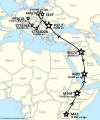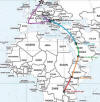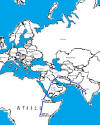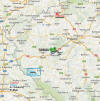|
State |
Immigrants |
families |
Locations
the immigrants settled |
(not all locations found yet)
Places some were known to come from: |
|
WI |
66 |
14 |
Algoma, Antigo, Appleton, Ashland,
Carlton, Manitowoc, Milwaukee, Oshkosh, Kewaunee & Brown Co. |
Appleton branch lived in Blahnik
Pocket (Smrzovice, Domazlice, Loucim), Prague
& Havlovice,
CZ.
Other Pocket villages; Starec, Novy Dvur, Radonice, Stanetice, Lhota,
Smrzovice |
|
IL |
12 |
5 |
Chicago, St. Charles |
Polenka near Klatvoy, Smrzovice,
Brnirov, Klatvoy (in the Blahnik Pocket) , Strasice by Plzen |
|
IA |
8 |
5 |
Jones Co, Linn Co, Oxford Jct, Cedar
Rapids |
Mlynic/Allynace, Cz in 1893 |
|
MI |
8 |
2 |
Menominee |
Smrzovice and Lhota in the Blahnik
Pocket |
|
NY (Blacknik) |
7 |
3 |
Manhattan |
Stanetice, Oprechtice and Smrzovice
|
|
MN |
5 |
3 |
St. Paul, Lancing, Austin, Mower,
Pine City, Tarbor |
Volduchy near Plzen |
|
NJ |
1 |
1 |
Bridgewater |
unknown |
|
PA (Blamick) |
4 |
1 |
Allegheny |
Myto near Plzen |
|
MO/CA |
3 |
1 |
Kansas City, San Francisco |
Loucim (Blahnik Pocket) |
|
Canada |
3 |
1 |
Winnipeg/Grande Point, MB |
U Blahniku (Blahnik Pocket) |
|
total |
117 |
36 |
|
|
Wisconsin gained it's statehood in 1848. This occurred
about the same time as the serf statues was lifted in Bohemia. There was a
great deal of advertising in Czech and German newspapers encouraging people come
to settle this new state. This is probably why there were so many Czechs
coming to Wisconsin between 1850-1880. In 2011 the White pages the
people with the last name of Blahnik had grown to 821
from these 118 immigrants. One third of these Blahniks were still living
in Wisconsin. Wisconsin had the most Czech immigrants in
the 1860 & 1870 census records for the US. More than half of our Blahnik families
did immigrate to Wisconsin and the Midwest, but we have settlements as far away
as Canada too.
In 2011 the greatest number of Blahniks in Czech
continued to live in this same SW area of the
Czech Republic. Domazlice to Klatovy has the
highest population of Blahniks from land line phone records. In 2011
the land line records in Czech showed 519 listings while the US showed 821
listings. Wisconsin still showed the greatest number of Blahniks and
had increased from 66 immigration families to 303 homes some 150 years
later.
A note should be made here about how the numbers gathered
for this comparison. Cell phones are more common in Czech currently
than Land Lines are, so it is
possible that this is not as direct of a comparison as one might think.
Still, the Blahnik immigrants definitely established themselves on the North
American continent.


In 2012 a DNA group was up to see how we might
all relate. The information will be presented by the name
of the oldest known ancestor from each Blahnik family. Currently
five different families (Male family lines) have
been discovered.
Although 65 Blahnik families were identified at the
time of immigration, it was discovered that some of them were related to
others and also that some families died out with the Blahnik name (having
either no children or daughters only).
DNA and Genealogical attempts to identify our
Families
In 2011 there was a Blahnik family reunion held at
Blahnik Heritage Park in Algoma, WI. Blahniks from all over the world
were invited to attend. From this reunion the idea establishing a
Blahnik DNA group was discussed. Three Blahnik men initiated this
group and had no common ancestor back to the 1700's. All three of
these men were from a short distance from each other in NE Wisconsin.
They all turned out to be related. Other Blahnik males joined the
Y-DNA group to test for their paternal ancestry line.
So far, fifteen different male Blahniks from
what seemed like separate families took the DNA
test which resulted in these five different
groups. The groups are being identified by the
oldest known ancestor and the Haplogroup affiliated with them. The majority
of Czechs have an �R� or R1b Haplogroup (roughly
36%). None of our Blahnik families belong to this group. �R� is often
associated with the Celts and the Boii tribe was
said to have been pushed over the Alps into Czech (Bohemia) by the
Romans. Three of our Blahnik families came from
the "I" group mutation while the other two come from "L" and "N".
The Five DNA Haplo Groups
There is an article in the December 2013 issue of Nase Rodina. That is the
Genealogical Magazine from CGSI (Czechoslovak Genealogical
Society International) and discusses our
Blahnik
DNA Project. The info below expands on some of the DNA groups
while a fuller explanation for the Libkov group can be found in this article
1- Haplo I2a or I-P37.2 Lipkov,
Bohemia includes families from Czech villages
Smrzovice, Kout,
Vitovky, Myto (PA) and Loucim, CZ. Also immigrant locations for Winnipeg
Canada, Algoma WI are included with
this group. This includes both American
and Czech DNA samples. The oldest known ancestor
was Ondra Blahnik c1455 Libkov (between Domazlice and Klatovy) -after
1482.
This appears to be the largest Blahnik family both in Czech and North
America. See ancestral migration map below and the
known genealogical tree that we currently have available. There were some branches that split off the
trunk earlier which are likely the Kout, Vitovky and
Loucim Blahniks. Though they are connected genetically, the
genealogical connection has yet to be found.
LIBKOV BLAHNIKS


2-
Haplo
N1C1 or
N-M231
has been found for two different families. There is an immigrant family
named Blahnik who settled in
Ashland, WI. Their
oldest known ancestor was Jan (John) Blahnik c1825
possibly Chodska Lhota, Bohemia. There was also a man in
Prague, Czech Republic that match his DNA with this
Wisconsin family whose oldest known ancestor was
Frantisek
c1875 from the Village Trhanov (near Domazlice) Bohemia.

Mike Glime estimates that these two branches shared
the same direct ancestor in the late 1700's. There is also a third
party match with a man whose last name is Stanley. This means the
family split between the Blahniks and this man's family probably occurred
before the standard use of last names. The N Haplogroup is frequently
found among the Turks, Russians, Finns, Baltic, Eastern Prussia and even in
Russia. The exact path of this family to Czech has not been determined
at this time. Perhaps the most likely place could be from Eastern
Prussia which is close to Czech. I should be noted that there is an
FTDNA direct match with a Mr. Stanley in Slovakia. The split with the
Blahnik may have happened before last names became commonly used.
3- Haplo I1
or I-M253 belongs
to one of the immigrant families that settled in Iowa. The oldest
known ancestor for this group is Georg (Jiri) Blahnik b: in Bohemia
estimated birth 1840. He married Dorothea (Janva) Janca Janda and they
lived in Mlynec, Klatovy in the mid 1800�s.

There are a few Blahnik immigrant families that came to
Iowa. One family has been tested so far. The FTDNA program
suggests the I1 lineage may have started in northern France. It was
found most frequently in the Viking/Scandinavian area of NW Europe and spread
from there down to Central and Eastern Europe. This Haplo DNA marker is not shown in
great frequencies in East/Central Europe but is likely how this Blahnik
group came to Czech.
4- I2b1 or
I-M223
is the Haplogroup for an ancestral Blahnik family from
Ledvice. The oldest
known ancestor of this group is Joseph
Blahnik 1875 Ledvice, Bohemia. This family emigrated to France before
coming to America in the next generation.
Descendents can be found in IL and WI.

The basic migration map is similar to both the
Libkov Blahniks and the I-M253 Iowa group since they all come within the "I"
group mutation. From the basic "I" mutations they took slightly
different paths. FTDNA suggests that I2b1 may actually have had its
roots in Northern France like I1. This group probably took a similar
path as the I-M253 Blahniks since it is a genetic subgroup.
Haplo I2b1 external link.
5-
Haplo
L-M61
was found for the group known as the Volduchy
Blahniks. The oldest known ancestor was Matej Blahnik b:
c1775 Bohemia. The family lived in
Litohlvy (just east of Plzen) in the early 1800's. Two generations
later Frantisek left from Minnesota USA in 1906.

The L-M61 is an interesting Haplotype for
this Czech family. One source suggests that
50% of the men living in southern India have this marker.
It should be noted that it is also common in the Middle East among the
Turks, Saudis and Pakistanis. Perhaps the Volduchy Blahnik group
came through the Middle East making their way up to the Czech Republic.
Research continues and this current path may alter. Certainly India is
where most people with this L Haplo are now living .
Not all Blahnik lines have been
tested to see how we all connect.
This project is looking for a
Blahnik male from the family lines of
1-
Jos Blahnik & Tulachka to
Kewaunee, WI,
2-
Polenka, Klatovy -Oxford Jct. IA & Chicago, IL,
3- Another male from a Cedar Rapids, Iowa
group.
A basic $60 test would indicate which of the 5 family lines
belong to them.
The Blahnik DNA group is open for more testing. There
are Blahniks in other European Countries as well as other immigrant families
who have not been tested. We invite any male Blahniks (also spelled
Blacknik and Blamick with some American immigrant families) to join and
connect with your Czech Cousins.
Feel
free to
contact this author









